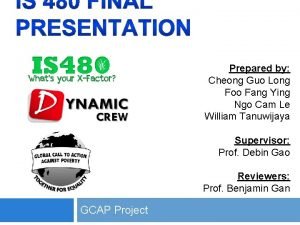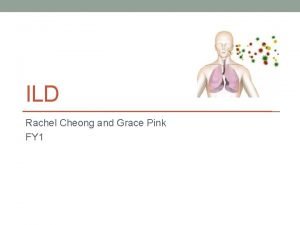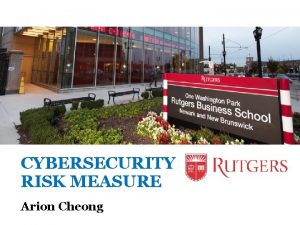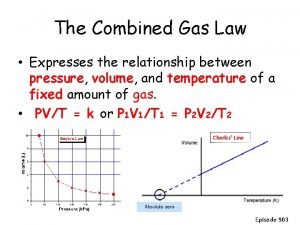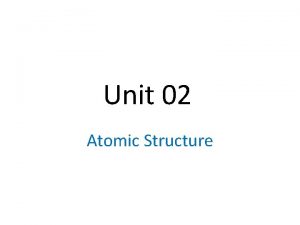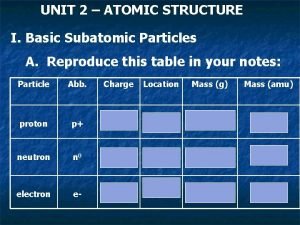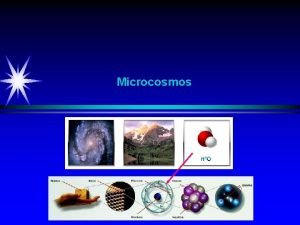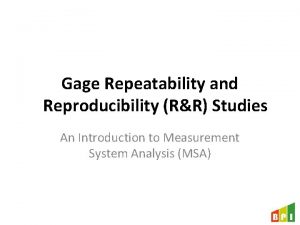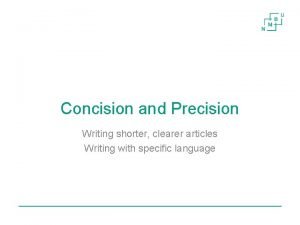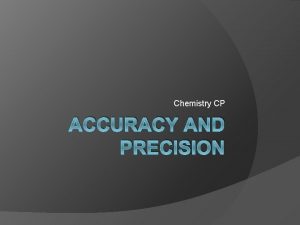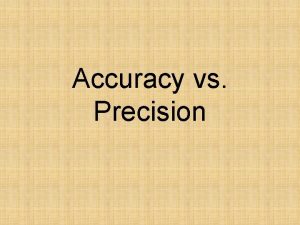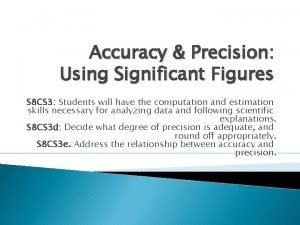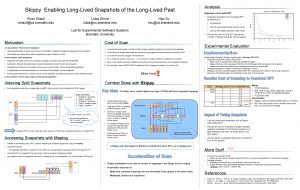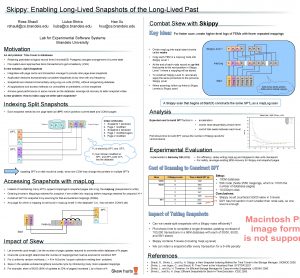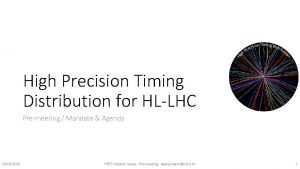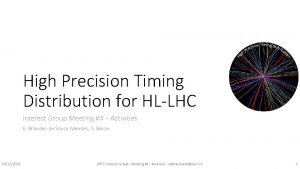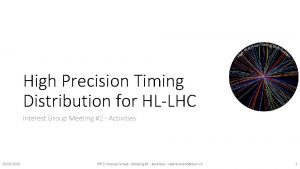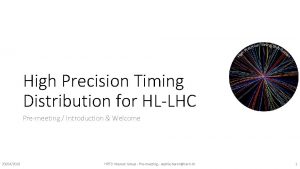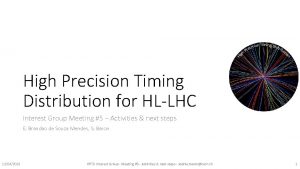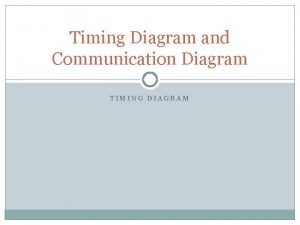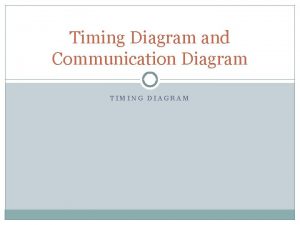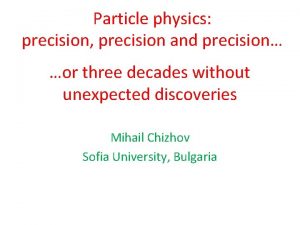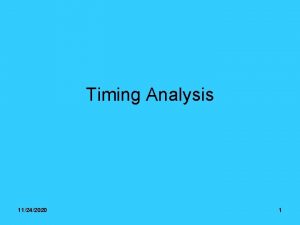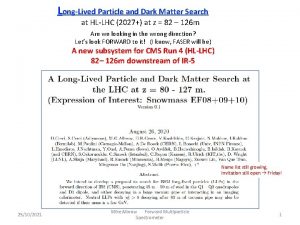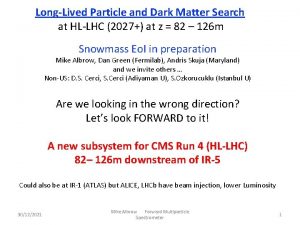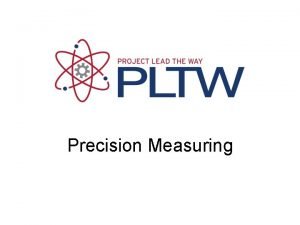Precision Timing and LongLived Particles HLLHC Cheong Sanha





























- Slides: 29

Precision Timing and Long-Lived Particles @ HL-LHC Cheong, Sanha; Dutta, Irene; Han, Yubo; Li Ke; Safdari, Murtaza; Tarek, Ahmed; Taylor, Devin SLAC Summer Institute (SSI) 2018 1

Outline ● Introduction to Precision Timing at the HL-LHC NOT Λ ● Triggers ● Supersymmetry with RParity Violation ● Long-Lived Particles (LLP) ● Results ● Summary 2

Introduction to Precision Timing at HL-LHC ● Upgrade to High-Luminosity-LHC (HLLHC) by year 2026 ● Ultimate luminosity of 7. 5 x 1034 cm-2 s-1, 200 pile-up (PU) vertices ● More collisions at the same energy! CMS Simulation CERN-LHCC-2017 -027/LHCC-P-009 Number of pp collisions per unit length of beam axis 3

Physics at the HL-LHC Advantages ● Better chances of finding rare, maybe BSM phenomena ● SM measurements with increased precisions ● New phase space for exploring long-lived particles (LLP’s) Challenges ● Greater spatial overlap between particles →failure of the existing Particle Flow algorithm ● Track-vertex association ● Acceptance reduction for isolated objects ● Reduced resolutions on missing transverse momentum (MET), jet energies, etc. ● Trigger for rare events 4 → this

130 PU vertices reconstructed from a special run in 2016 5

Need for Time-of-arrival Measurement ● Time-of-arrival measurement can separate collisions that are very close in space, but separated in time ● Slice bunch crossing in exposures of 30 ps ● PU levels drop to current LHC levels CMS Simulation CERN-LHCC-2017 -027/LHCC-P-009 6

CMS Detector Upgrade Electromagnetic Calorimeter 150 ps resolution Timing layer - 30 ps resolution for charged particles 7

ATLAS Detector Upgrade High-Granularity Timing Detector (HGTD) - 30 ps resolution for charged particles LAr Timing - 150 ps resolution ATLAS HGTD talk - ICHEP ‘ 18 8

Triggers in Particle Physics Experiments ATLAS Trigger system (Run 2) Bunch crossing (40 MHz) ~2. 5μs Aim of Trigger System Decide online whether to store a given event from a bunch-crossing. Level 1: rate defined by ATLAS readout capability Level 1 Trigger (100 KHz) High Level Trigger (1 KHz) ~250 ms Storage (1 k. Hz) Similar system for CMS! Hardware-based Level 1 Trigger Receiving inputs from L 1 calorimeter, L 1 muon triggers, etc. Trigger objects: electrons, photons, tau leptons, jets, MET, muons No existing triggers uses timing information at the low-level! 9

Supersymmetry (SUSY) ● Mathematically elegant ● Coleman-Mandula Theorem ● Can solve the hierarchy problem ● Gives a candidate for dark matter 10

R-Parity Violating (RPV) SUSY ● Superpartners of the Z boson (zino), the photon (photino) and the neutral higgs (higgsino) mix to form four mass eigenstates called neutralinos ● Lightest of the four neutralinos is denoted as ● PR = +1 for SM particles, PR = -1 for SUSY particles ● R-Parity conserving: a SUSY particle decay must contain a SUSY particle ○ Lightest SUSY particle cannot decay ⇒ MET ● R-Parity violating: the LSP can further decay to SM particles. ○ SUSY → fully SM decay ⇒ no/low MET 11

Long-lived Particles (LLP’s) ● SUSY/BSM particles with lifetimes of ~few ns or longer ● Macroscopic, reconstructable path length / time difference ● Experimental signatures: ○ Displaced objects ○ Non-pointing/kinked objects ○ “Muons” without inner tracks ○ Delayed objects 12

Timing the Delayed Objects In non-prompt productions, there might be delay in arrival time due to: ● Longer path traveled ● Slow, long-lived intermediate X where 13

RPV SUSY with Long-lived Neutralinos is long-lived and slow ⇒ Displaced, delayed di-jets with MET/lepton 14

L 1 Trigger Design Ideas Delayed Jet triggers ● Sum of energy deposits in the calorimeter clusters but tag the region as delayed if sufficiently separated in time from bunch crossing (eg. 600 ps) Delayed HT (scalar sum of tower ET) trigger ● ● Total sum of all delayed calorimeter energy deposits Our choice for this work Displaced/Delayed vertex trigger ● ● ● HL-LHC upgrade plans to include L 1 tracker trigger Use time and vertex information to tag displaced/delayed jets If LLP’s have lifetimes of a few ns, very well separated from the displaced btagged vertices 15

Trigger Rates (current & estimate) ● Require time delay significantly longer than the time spread across beams (~200 ps) ⇒ Reject background, 600 ps ~ 3�� ○ Not considering out of time rate ● HT Trigger Thresholds ○ 350 Ge. V ⇒ rate ~4 k. Hz ○ Delay of 600 ps, 180 Ge. V ⇒ rate ~0. 1 k. Hz HT 16

Effects of New Timing Trigger (delayed HT) Total energy deposits in the Calo towers with �� t > 600 ps 17

Signal Efficiency of Our Delayed HT Trigger 18

Delayed Towers due to Slow LLP’s 19

Summary Key points ● Timing upgrades at ATLAS & CMS expands our reach to explore BSM physics ● New low-level trigger possibilities ○ Current triggers might not catch LLPs ○ Simple delayed-HT trigger can be sensitive to late jets ■ cτ≈O(1 m) can be triggered with the proposed detectors ■ Significantly lower HT cut with reduced prompt/in-time backgrounds ■ Even for lighter particles, displaced vertices create enough delay Much more work to do… ● Understand the existing results Warning ● Study w/ full simulations ● Background studies : Latecomers will not go unnoticed! 20

Thanks! Particles 21

Backup 22

ATLAS: Timing in LAr Calorimeter Current LAr calorimeter has decent timing! ● ● ● Study based on W→e�� and Z→ee samples Timing resolution ~290 ps for high-energy EM cell ○ 220 ps due to beam spread ○ 190 ps intrinsically due to LAr Expected to be higher for unbiased QCD jets ATLAS Run-I Analysis 23

CMS Timing in Pb. WO 4 Crystal ECAL 24

ATLAS DAQ system run 2 25

CMS Single Jet Trigger Rate ● Single Jet ○ Threshold of 180 Ge. V @rate ~2. 5 k. Hz ○ Threshold @ 0. 1 k. Hz with delayed energy cut ~ 80 -100 Ge. V Single Jet 26

Trigger performance and challenges for LLP Trigger Challenges: L 1: no existing trigger for LLP. relay on other “random” triggers like: Jet+MET, leptons, photons… -> cannot directly trigger on it? HLT: very few analyses dedicated HLT path -> not sure about the signature we should use based on current trigger system? As a results: Acceptance of LLP < 10 -3 Uncertain decay place -> fixed in this project ->(try to trigger LLP directly) how well calorimeter will trigger on di. Jets about few ns? 27

ATLAS HGTD upgrade Exploit the time spread of collisions to reduce pileup contamination ● Results in sizable improvement in various analyses techniques (PU jet tagging, b tagging, lepton isolation. . etc) 28

Signal: Delayed Towers 29
 Linear measurement tools
Linear measurement tools Semi precision attachments
Semi precision attachments Single precision vs double precision
Single precision vs double precision Arion cheong
Arion cheong Parkinsons plus
Parkinsons plus Cheong seong gyeong
Cheong seong gyeong Yuet cheong produce
Yuet cheong produce Debin gao
Debin gao Professor cheong hee kiat
Professor cheong hee kiat Ocean amber pte ltd
Ocean amber pte ltd Tyler wozniak
Tyler wozniak Rachel summer cheong
Rachel summer cheong Jeanie cheong
Jeanie cheong Chambumo gyeong
Chambumo gyeong Arion cheong
Arion cheong Relationship between pressure, volume and temperature
Relationship between pressure, volume and temperature Solid liquid and gas molecules
Solid liquid and gas molecules Properties of solid
Properties of solid 35 - 17
35 - 17 Atom and subatomic particles
Atom and subatomic particles Fundamental particles and interactions
Fundamental particles and interactions Motion of particles in solids, liquids and gases
Motion of particles in solids, liquids and gases Precision in information retrieval
Precision in information retrieval Repeatability and reproducibility
Repeatability and reproducibility Precision in writing
Precision in writing Accurate vs precise chemistry
Accurate vs precise chemistry Accuracy v precision
Accuracy v precision Precision and significant figures
Precision and significant figures Uncertainty in multiplication
Uncertainty in multiplication Why is it important to defend your faith
Why is it important to defend your faith







